Announcing SCE’s Youth Voice Challenge Partners
When we announced our Tech and Society Youth Voice Challenge last winter, we sought the answer to a single question: How can young people inspire their peers to use technology in healthy ways and make digital spaces better for everyone?
Six months later, the world looks completely different. COVID-19 has impacted the health and economic futures of millions. Across the United States, hundreds of thousands of people are marching to demand an end to police brutality and to state unequivocally that Black lives matter.
Our Youth Voice Challenge was never intended to directly address a global pandemic or racial injustice. But as our society goes through this period of transformative change, youth voice will be more important than ever.
With the future of in-person learning uncertain, young people are spending an unprecedented amount of time online. More than ever before, they’re using technology to connect with their families, peers, classmates, and online communities. And for the foreseeable future, technology will be how young people explore, discuss, and take action around critical issues.
In this context, young people need solutions that help them build positive and productive digital environments. Those solutions must be designed, tested, and implemented by youth themselves.
We’re proud to partner with nine exemplary organizations in search of youth-led solutions for a tech-enabled world. Each of our partners brings a unique approach to this work. All of them engage youth as leaders. Over the next two years, we’re excited to collaborate with this cohort, learn from their expertise, and share our learning with the field.
Read on to learn more about our Youth Voice Challenge partners.
Beam Center: Beam Center is a New York City-based makerspace that brings together youth, artists, engineers, and educators. Together, Beam Center program participants produce ambitious, collaborative projects that support youth to take bold steps towards meaningful futures and foster conditions for educational equity. To support a vision of digital public health for everyone, Beam Center will train and empower two diverse cohorts of young people to conduct their own research on Healthy Digital Futures. Their project will also support youth as they create a platform where they can share their findings with peers, youth-serving organizations and policymakers.
Digital Harbor Foundation: In 2013, Digital Harbor Foundation transformed a closed-down rec center in Baltimore into a vibrant Tech Center for youth. Since then, they have offered workshops and programs about technology and maker skills to both youth and educators. Digital Harbor’s project will provide approximately 40 Baltimore youth with the equipment, training, and mentorship to research, produce, and market their own podcast that discusses the most pressing technology issues they face today. Using this platform, youth will lead critical conversations about the role of technology in society.
Erikson Institute: Erikson Institute is a hub of complex, creative thinking that empowers adults to help children reach their fullest potential. They bring the newest scientific knowledge and theories of children’s development and learning into graduate education, professional training, community programs, and policymaking. Their project uses teen voices and experiences to research, develop, and implement a technology peer-to-peer mentoring program. It will honor and highlight youth perspectives and experiences, leveraging a strengths-based approach to supporting young people in healthy media use while building relationships between older and younger youth.
Games for Change: Games for Change empowers game creators and social innovators to drive real-world impact through games and immersive media. They convene industry experts through their annual Games for Change Festival, inspire youth to explore civic issues and STEAM skills through their Student Challenge, and showcase leading impact-focused games and immersive experiences through live Arcades for the public. Their project, Raising Good Gamers, will inspire young people to shape the culture of online communities, advance youth leadership and advocacy for safe, diverse, and inclusive gaming experiences, and build positive game communities that counter toxicity.
PeaceCasters: Based in Louisville, KY, PeaceCasters is a youth-led program housed within the Peace Education Program (Peace Ed) that empowers young people in middle and high school to share their stories with the world in order to create change through digital and social media. Through their groundbreaking Youth Influencers curriculum, they support young leaders to be influencers on social media and in their communities by sharing stories from lived experience, practicing positive communication skills, and building community online and off. Their curriculum is based on three pillars: empowered storytelling, social media for social good, and online conflict resolution. The PeaceCasters program builds on Peace Ed’s 37 years of experience training youth and adults to build and sustain positive relationships, bringing these essential skills into digital spaces and onto social media platforms.
Project Zero: Housed in the Harvard Graduate School of Education, the mission of Project Zero is to understand and enhance learning, thinking, and creativity for individuals and groups in the arts and other disciplines. Project Zero’s Reimagining Digital Well-Being will begin with empirical research that will help adults better understand the challenges that today’s youth face in their digital lives. Then, Project Zero will engage with youth in a participatory design project to develop a Digital Well-being Toolkit, which they will pilot and disseminate in partnership with youth-focused organizations.
Spy Hop: Spy Hop is a Salt Lake City-based digital media arts center offering in-school, after-school, youth-in-care, and satellite programming for students ages 9-19. Brave Voices, a youth-led participatory research, design, and media project, engages 400+ Utah youth in challenges, podcasts, and data storytelling to foster digital mindfulness and collective resilience. As digital auto-ethnographers, producers, and audiences, young people will create an open educational resource that shares both evidence-based insights and recommendations for building a better digital ecology.
Yale Center for Emotional Intelligence (YCEI): YCEI’s mission is to use the power of emotions to create a more equitable, productive, healthy, and compassionate society, today and for future generations. They conduct research and design educational approaches that support people of all ages in developing emotional intelligence and the skills to thrive and contribute to society. Their project will use a free program called InspirED to empower students to design and implement projects they believe best support healthy technology habits among their peers. Beyond the effects expected for participating schools, YCEI intends to promote these projects through its free website and share research findings about inspirED’s impact.
Youth Emerging Stronger (YES): YES’ mission is to provide runaway, homeless and foster youth (RHY) with safety, stability and housing, along with the relationships and resources to thrive now and in the future. They envision a world where resilient, self-assured, and hopeful youth are free from a life of homelessness and become capable of achieving positive, fulfilling futures. This youth-led project will help participants explore their own engagement with technology and ensure that their use of social media aligns with their long-term plans to enjoy academic and professional success. Once piloted, this project can be replicated for agencies serving runaway and homeless youth in Los Angeles and across the country.
Photo: student participant, Yale Center for Emotional Intelligence. © 2019. CASEL. All rights reserved.
Responding to the COVID-19 Crisis
As COVID-19 continues to spread, the work of nonprofits has never been more in peril. According to GuideStar, less than half of nonprofits maintain one month of operating reserves. As donations dry up, many organizations are facing difficult decisions: whether to cut programs, lay off staff, or shut their doors entirely.
At the same time, the work of these nonprofits has never been more important. COVID-19 does not discriminate about whom it infects, but communities of differing means have vastly different capacities to respond to the fallout. Lower-income communities where more people work in service industries suffer from higher rates of un- and under-employment. In communities with less access to technology, “remote learning” becomes nearly impossible. If the nonprofits that serve these communities shut down, we worry that those most in need will fall even further behind.
Since well before this crisis began, our partners have been laser focused on the needs of kids. These nonprofits work hard to ensure that kids can build critical SEL skills and healthy relationships with technology. As our nation’s children transition to online learning—potentially for months—the work of these nonprofits will help them succeed.
We’re determined to help our partners continue to serve youth as they navigate this challenging time. After speaking to our partners, other funders, and leaders in the youth development field, we’ve learned a lot about what nonprofits need right now—and made three commitments to support them through this crisis.
What we have learned:
- All of SCE’s direct service partners have paused their programming. Most are grappling with maintaining relationships with young people while also addressing the mental and physical well-being of program participants and staff. While some are able to transition to virtual programming, the online version of their work looks dramatically different than “business as usual.”
- Donations have slowed to a trickle, galas have been canceled, and endowments are taking a huge hit. Nonprofits are uncertain about when a government-funded recovery package will arrive. In these uncertain times, they are focusing on feeding kids, keeping kids safe, prioritizing kids’ mental health, and supporting staff.
- Foundations are adapting to the changing landscape by transitioning restricted program funding to general operating support, providing seed funding for pilot virtual programs, and contributing to local emergency response funds (such as this one for Chicago).
- We all need to be thinking about immediate, near-term, and long-term responses. While both nonprofits and foundations must evolve rapidly to respond to the immediate impacts of this crisis, we also must prepare for long-term economic impacts and potential changes to our education system.
Our commitments:
- We will share best practices. We will continue to collect and share resources for kids, families, educators, and program providers adapting to a virtual learning environment. We are compiling the resources we’ve found on this blog post, and will share them on Facebook and Twitter on an ongoing basis.
- We will help nonprofits transition to virtual support and programming. We encourage our current and future partners to develop online programs and research best practices in virtual learning. We will support them as they implement virtual experiences, expand access to technology for their constituents, offer online professional development for their staff, and shift to remote work.
- We will continue to listen. Conversations with current and potential partners, other funders, and experts in youth development led directly to these shifts in our strategy. The only way we will weather this storm is by listening, learning, and working together.
Today, we face one of the greatest challenges we have seen in generations. But this unprecedented crisis offers us glimpses of a possible future—a future where remote work is commonplace, where technology facilitates connection, and where well-developed social and emotional skills matter more than ever. By working together, we can help nonprofits and the youth they serve to survive the present and prepare for the future.
Photo by Annie Spratt on Unsplash
COVID-19: Resources for Educators, Nonprofits, Parents, and Kids
Whether you’re a teacher figuring out how to build a remote classroom for third-graders, a nonprofit transitioning to virtual programming, or a parent getting used to having kids around 24/7, COVID-19 presents a slew of new challenges. If you’re struggling to adapt to this “new normal,” fear not: our partners and friends in youth development have developed resources that will help you adapt.
For Educators:
- America’s Promise Alliance: Resources for Educators and School Staff
- CASEL: COVID-19 Resources for Educators
- Digital Promise: Online Learning Resources
- Greater Good in Education: Practices for Student Learning
- Wide Open School: Resources for Educators – Grades PreK-5
- Wide Open School: Resources for Educators – Grades 6-12
For Funders and Nonprofits:
- Forefront: COVID-19 Updates and Resources
- National Council of Nonprofits: What Steps Should Nonprofits Take?
- Third Plateau Social Impact Strategies: Organizational Crisis Response Webinar Series
For Parents:
- America’s Promise Alliance: Resources for Parents, Families, and Caregivers
- CASEL: COVID-19 Resources for Parents and Caregivers
- Common Sense Media: Resources for Families During the Coronavirus Pandemic
- Digital Adventures: Fun and Engaging Online Classes
- Free Spirit Media: COVID-19 Response Hub
- Greater Good in Education: Practices for Parents to Try
- Sports Philanthropy Network: Resources for Athletes and Sports Organizations
- Wide Open School: Resources for Families – Grades PreK-5
- Wide Open School: Resources for Families – Grades 6-12
For Kids:
- America’s Promise Alliance: Resources for Young People
- DoSomething: Coronavirus Resources and Action Campaigns
- Greater Good in Education: Practices to Support Student Mental Health and Well-Being
Photo © Common Sense Media
How Can We Harness the Power of Tech?
This blog is the first in a series exploring our evolving thinking on the relationships between technology and society. We look forward to learning more about this emerging topic, and to sharing what we learn along the way.
Picture a typical weekday. If you’re anything like us, you check your phone within a few minutes of waking up. You’ve scrolled through Instagram or Facebook by the time you’ve had your morning coffee. You read an article or two on your way to work, where you’ll spend seven or eight hours on your laptop. You’ll message friends and family throughout the day, and when you get home you’ll look forward to winding down with an episode of your favorite show on Netflix (for us, that’s currently the Great British Baking Show).
It’s undeniable that technology is all around us. But the impact of that technology — how it’s affecting individual people and our society at large — is far harder to describe.
We think that it’s important to build positive and productive relationships with the technology we use every day. But how? And what does a positive, productive relationship with technology even look like?
It’s questions like these that inspired us to launch our Tech and Society program area, a new funding opportunity focused on youth voice, and a year-long design project to better define and understand this space. We’ve already done several months of research, partnering with great minds and inspiring organizations eager to learn more about this emerging issue. We’re excited to share what we’ve discovered so far.
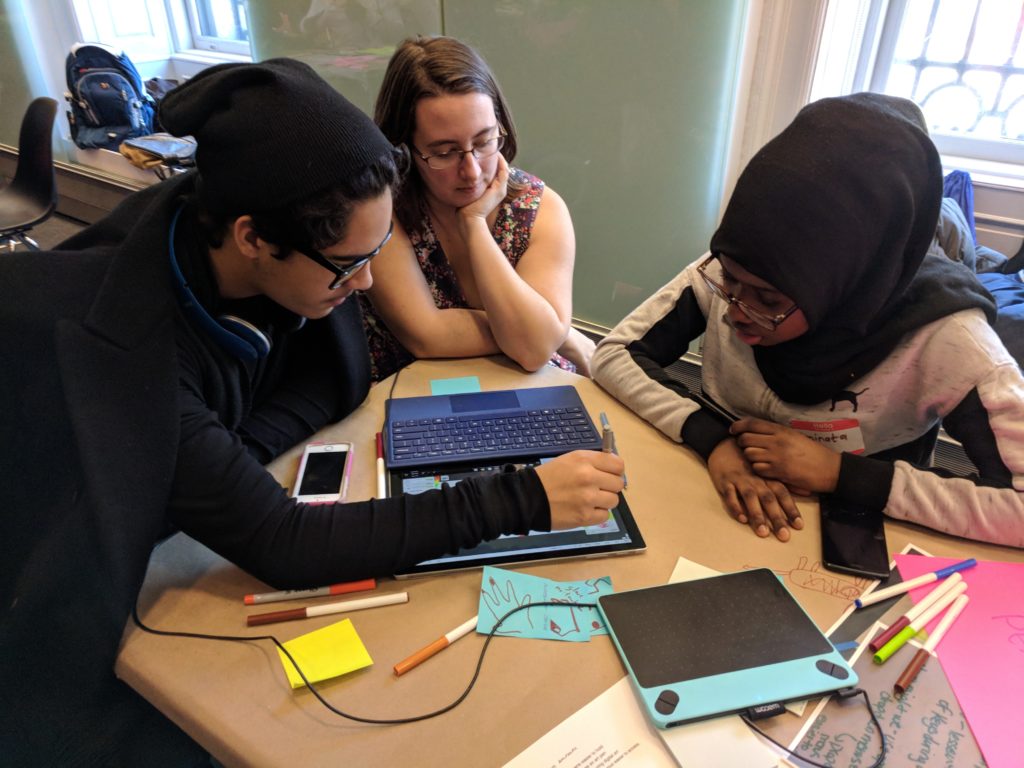
We first dipped our toes into this issue area about two years ago. After eight years funding social and emotional learning and digital learning, we began to wonder how those two areas might intersect. How is technology influencing our relationships and individual and collective well-being? And how can people — especially young people — engage more thoughtfully with the technology that’s all around us?
In late 2018, we launched a partnership with Chicago Ideas designed explicitly to explore this space. Our collaboration kicked off with a series of focus groups with Chicago Ideas’ youth ambassadors. We asked these teenagers about various forms of digital citizenship, such as online privacy, freedom of speech, and critical consumption. Two things quickly became clear: 1) kids think about these concepts every day, and 2) digital citizenship only paints a partial picture of teens’ online lives.

Further work in this space confirmed these hypotheses. A second partnership with DoSomething.org layered in the concepts of youth voice and agency, and the next phase of our work with Chicago Ideas led to the development of a set of resources — including one focused on digital ethics — for young people seeking to engage more thoughtfully with online life.
The more we engaged with this space, the more complex we found it…. and the harder it became to define. We talked to kids, parents, nonprofit leaders, and other funders; everyone was interested in this issue, but nobody seemed to know quite what to call it or how to address it. Terms like digital citizenship, digital well-being, and screen time circled around the larger topic that interested us, but none of them fit quite right. We wanted to explore how human issues like identity, mental health, personal relationships, and many more were affected when filtered through the lens of technology. It’s a massive issue that we know far too little about, and it grows more urgent with every new advancement.
So we brought in some help. We partnered with a Chicago-based design thinking firm to help build a year-long project to convene the best and brightest minds in this space. Our goal was to give this issue a clear definition and framework, bring together the great thinkers already doing brilliant work, and build a movement to make tech work better for all of us.
In our next blog post in this series, we’ll share what we’ve learned from this process so far. Stay tuned!
Photos © Chicago Public Library, Digital Harbor, and Dreamyard / David Flores
#DearSocialMedia: Teens Tell Tech Industry What Needs to Change
It’s no surprise that a generation that grew up on the internet has plenty of insights on how to make it better. In partnership with ATTN: Media and Chicago Ideas, we launched a campaign to encourage our future leaders to tell us how they really feel about technology and social media.
Learn about the campaign. Watch the video. Share your voice. Check out #DearSocialMedia.
Don’t retire, kid: Our four biggest takeaways from the Project Play Summit

Young athletes share their stories at the Project Play Summit.
Don’t retire, kid.
That message anchored the Aspen Institute’s 2019 Project Play Summit, which brought more than 500 leaders in sport and youth development to Detroit this September. Over two days, representatives from national athletics organizations, nonprofit and philanthropic professionals, parents, and kids discussed how we can make sports work for all kids.
There’s a major need for these conversations. A recent study by the Aspen Institute found that most kids “retire” from sports by the age of 12. Just 38% of kids between ages six and 12 play sports regularly—down from 45% in 2008. Sometimes it’s because sports are too expensive; travel and equipment can cost thousands of dollars per year. Sometimes, it’s because sports get too competitive or intense. When sports stop being fun, kids stop playing.
This is a big concern. Kids who don’t play sports miss out on a guaranteed form of physical activity; they’re less likely to get the amount of exercise they need to stay healthy. However, they also miss out on opportunities for social and emotional development. When they’re done right, organized sports can help kids build self-esteem, set goals, learn teamwork, and practice leadership.
At the Susan Crown Exchange, we’re all about preparing kids to thrive. We’re especially interested in social and emotional learning (SEL) – the development of skills like empathy and collaboration, which have been linked to improved academic results and better life outcomes for kids.
Sports certainly aren’t the only way that kids build these skills. But with 45 million kids playing sports each year in the US alone, the potential is huge. We came to this conference with an open mind, excited to hear from a diverse set of experts on how we can make sports better for kids. Here’s what we learned.

The session we co-hosted with the Aspen Institute: How to Coach Social and Emotional Skills
- Sports aren’t just physical. We believe that social and emotional skills are critical for a child’s development. As it turns out, we’re not alone. Together with the Aspen Institute, we hosted an interactive session about why these skills matter, how sports can help children build them, and the role of coaches in a young athlete’s development. Nearly 100 people from a variety of backgrounds attended. Our participants gave us invaluable insights into how we can empower coaches to adopt SEL-informed approaches, making sure that the young athletes they support are prepared to thrive.
- We need to make sports better for kids. No matter where they came from in the world of sport, it seemed that everyone agreed on this. Parents spoke compellingly about the pressures their children faced from a young age. A panel of children agreed. Nonprofit leaders stressed that some kids can’t access sports at all—kids from low-income homes are half as likely to play sports as their upper-income peers. These are thorny issues, and we need to tackle them from all angles. We think that well-trained coaches will be particularly instrumental in addressing issues like these, and that an SEL-informed approach to coaching can have an outsized impact on the social and emotional development of young athletes.
- There’s a lot we’re still figuring out. It seems that everyone agrees that something needs to be done to make youth sports better. What’s less clear is what. Being fairly new to the world of sport, we were fascinated by some of the open questions that came up. Given what we know about the pressure kids are under, what is the role of competition? How can parents promote sports sampling—encouraging kids to try different sports—without overscheduling their children? How can we increase the demand for well trained coaches? These are questions that the field hasn’t answered yet—but it’s white spaces like this that excite us.
- Everyone has a role to play. Perhaps our favorite part of the conference was the diversity of perspectives welcomed. A panel of kids shared their experiences with sport. Their parents followed up with their own stories. Athletes with disabilities and their able-bodied teammates spoke candidly about what they each had learned from participating in integrated sports. And civic, philanthropic, and business leaders discussed the large-scale interventions needed to bring sports to more kids on a macro scale. Keynote speaker David Brooks referred to sports as a “social fabric” that can help build a just and kind society; it’s clear that many actors play a part in weaving that fabric together.
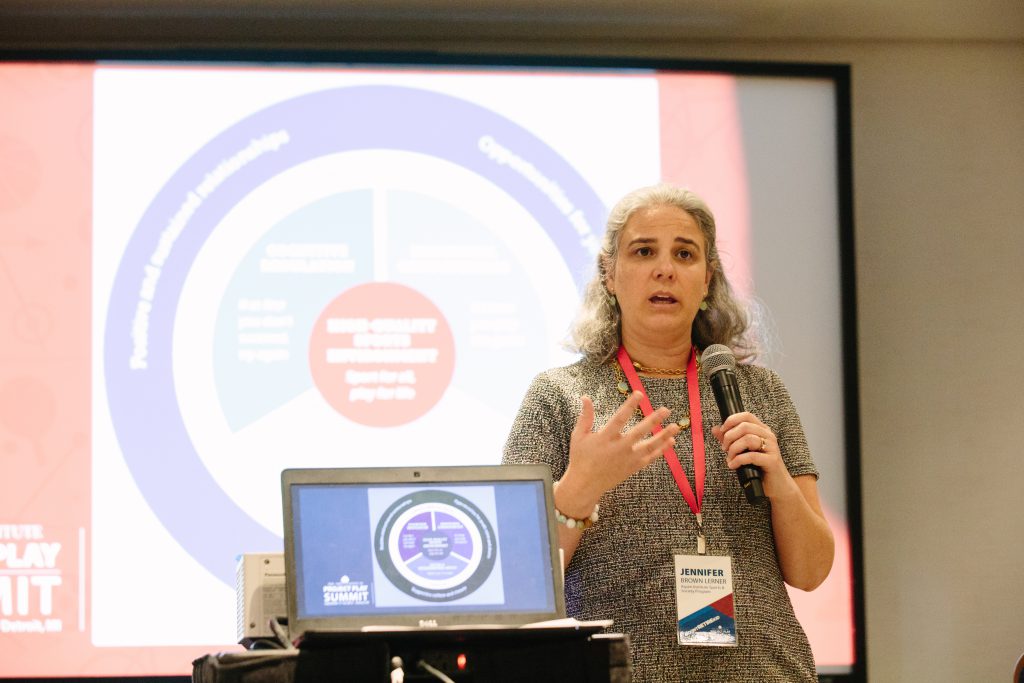
Jennifer Lerner of the Aspen Institute’s Sports & Society Program introduces the session.
As we explore the connections between sports, SEL, and youth development, we’re excited to keep learning—and to think about how we might play a part. If you know of any great resources or organizations that are also interested in this topic, let us know. We’d love to learn from them.
Learn more about our partnership with the Aspen Institute here.
All photos © Aspen Institute Project Play
REFUNITE: Reconnecting Refugee Families
When conflict escalated in the Democratic Republic of Congo in 2013, 16-year-old Tino fled the country—leaving his entire family behind.
Sadly, Tino’s story is a common one. The DRC has suffered ethnic, political, and economic conflicts for decades—conflicts that have driven millions of people from their homes. Refugees and internally displaced people are forced to leave quickly. Like Tino, many become separated from their families in the process.
There are over 65 million forcibly displaced people around the world. Many of those people don’t know where their loved ones are.
Our Catalyst Grants are meant to address urgent issues like this by supporting organizations that approach them in new and promising ways. Last year we offered a Catalyst Grant to REFUNITE: a nonprofit that uses simple technology to reconnect refugees with their missing families.
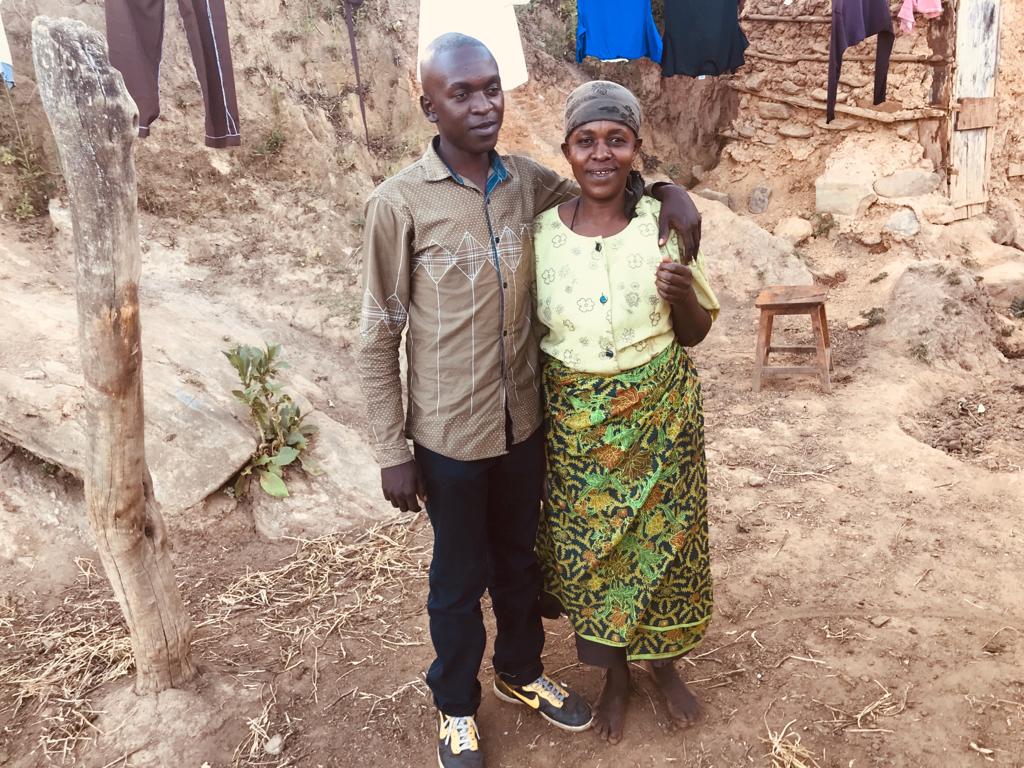
REFUNITE believes that everyone has the right to know where their family is. Photos © REFUNITE.
Living in neighboring Uganda, Tino didn’t know if he would see his family again. Until he found REFUNITE.
There are many reasons that displaced people struggle to find their loved ones. With their families also fleeing conflict, refugees can’t just call home and expect someone to pick up. Family members find themselves in different camps, countries, or continents. What little information might be available is often spread across several nonprofit organizations—and recorded in languages that refugees don’t speak.
When brothers Christopher and David Mikkelsen founded REFUNITE in 2005, they sought to cut through this confusion and give displaced people a single platform for family reconnection. REFUNITE has worked with Ericsson, the United Nations, and local mobile network operators to create a user-friendly database containing over 1 million profiles of displaced people. This network can be accessed through a mobile phone, computer, or help line, and is available in 17 countries where displacement is commonplace.
Simultaneously, REFUNITE has worked to create genuine economic opportunities for displaced people where such opportunities are scarce. In Uganda, the nonprofit is piloting a program called LevelApp that pays refugees to sort and label the images that help computer algorithms get smarter. Tech companies pay well for this service; in the communities where it’s offered, participating refugees earn three times more than those that do not. The 10,000 people who participate in LevelApp have already categorized over 175 million images—demonstrating the powerful potential of bringing digital jobs to refugee communities.
These platforms are major steps in the right direction. But perhaps REFUNITE’s greatest innovation is its network of more than 6,000 community leaders—leaders with deep roots in places with limited access to mobile phones. This network has a collective reach of more than five million people across 35 countries. If a user like Tino notifies REFUNITE that he’s looking for a family member, REFUNITE will blast a text message to community leaders active in areas where Congolese refugees often end up. Those local leaders connect refugees with family members in remote regions that REFUNITE staff wouldn’t otherwise be able to reach.
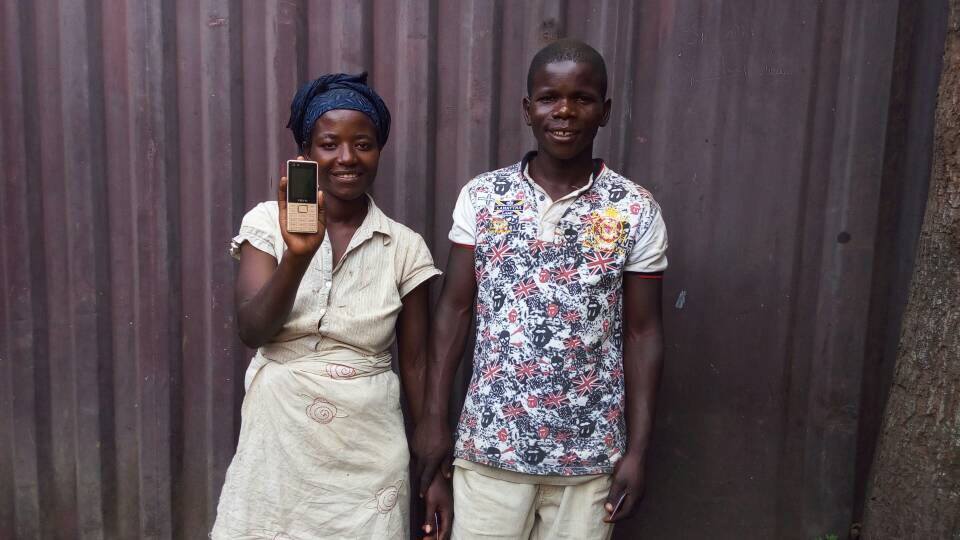
Tino, his mother, and the cell phone that helped reunite them.
When Tino fled the country, his mother also left—first to the capital of Kinshasa, and then to France. Five years later, she saw a notification on her phone: “You have one new message. To read it, go to m.refunite.org.”
The message was from Tino. And he was contacting her from Uganda—thousands of miles away.
Since 2005, REFUNITE has received more than 1 million registrations. Every day, they organize over 2,000 searches. And they’ve reconnected over 40,000 families. We’re proud to have played even a small role in supporting REFUNITE’s mission.
Behind every one of those 40,000 connections is a story like Tino’s. When he talked to his mother for the first time in five years, he didn’t know what to say. Eventually, he spoke: “Mom, I love you so much.”
We asked teens how to exercise better judgement online. Their responses blew us away.
“How might we improve people’s judgement in digital spaces?”
This was the question that guided the Untagle the Web hackathon, a two-day event we hosted this summer in collaboration with DoSomething.org. We gathered 15 exceptional young people who had expressed an interest in improving online life and asked them to develop a wireframe for a tool that would do just that.
Untangling the web
Last year, we partnered with DoSomething to develop Untangle the Web, a campaign designed to kickstart intergenerational conversations about digital life. DoSomething asked young people to take a quiz about how they used technology and media. Based on their responses, they received a digital personality and an action guide to help them start a conversation with an adult in their life. Whether a News Detective battling misinformation or a Ray of Sunshine spreading positive vibes, each young person shared an insight about their relationship with technology with a trusted adult.
Through this campaign, we aimed to reach 25,000 young people. Fifty-five thousand took the quiz.
Clearly, this project struck a chord with youth. We saw that young people recognized the effects that technology had on their lives and were desperate for resources that would help them navigate online environments.
Building on this momentum, we identified a small subset of the most engaged teens and asked them to apply for a hackathon—a two-day event where they could actually design a product that would help their peers untangle the web. We selected 15 of the most promising applicants from around the country and flew them out to New York City to participate.
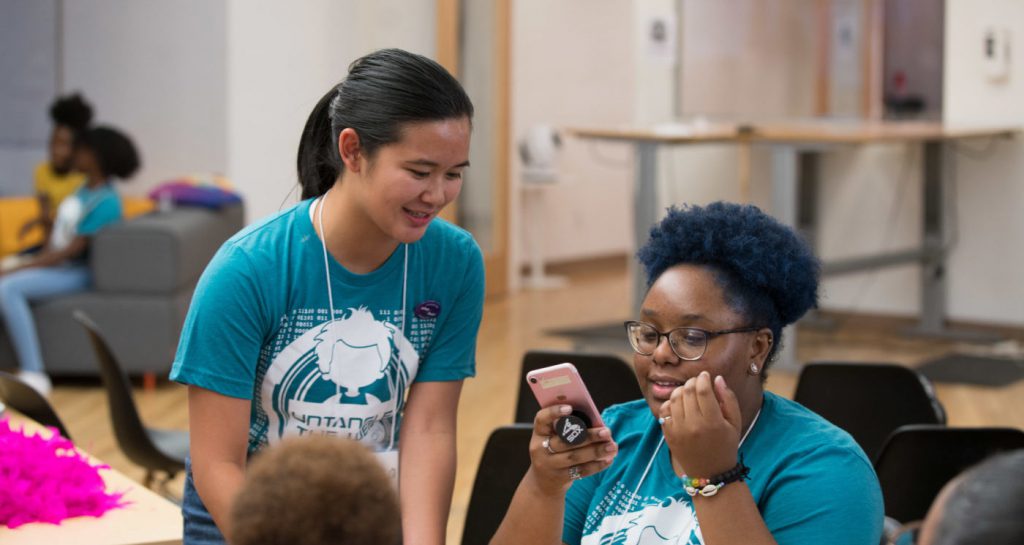
Designing a mobile application to improve judgement in digital spaces. © DoSomething.org
The Hackathon
Working in small groups under the guidance of DoSomething mentors, these 15 teens developed wireframes for products that addressed our challenge question: “How might we improve people’s judgement in digital spaces?” They then presented their ideas to a panel of judges with diverse experiences in technology:
- Samarth Bhaskar, Senior Editor for Digital Transition Strategy, the New York Times
- Ross Dakin, adjunct professor of computer science, Lehman College
- Tej Gokhale, Civic Action Lead, DoSomething.org
- Jerelyn Rodriguez, co-founder, The Knowledge House
- Calvin Stalvig, Director of Youth Programming, Beam Center
We wanted to make sure our participants had plenty of space to develop their own ideas, so we only had a few requirements. Products had to be feasible, with a well-articulated problem, simple solution, and clear distinction from applications already on the market. They had to be functional, with a fleshed-out user experience. Lastly, they had to be integrated with existing online platforms.
Working in teams of three, our participants developed five product ideas:
- Thinklight: a chatroom that connects users with mental health professionals.
- ZiN: a bot that sends users daily affirmations that reinforce positive behaviors.
- VeriLegit: an application that uses existing databases to judge the accuracy of online media.
- HideOut: a service that clarifies who will see the personal information that users share.
- BullyBeeGone: a program that automatically hides and deletes abusive comments and messages on social media.
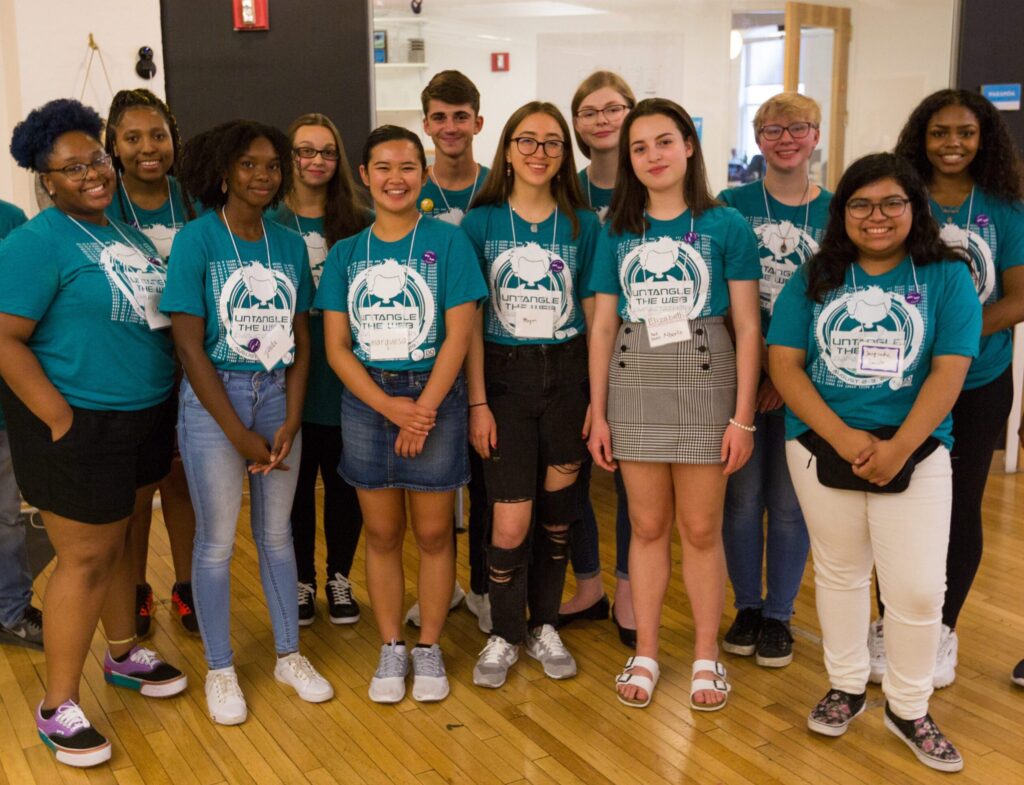
The 15 participants. © DoSomething.org
What did we learn?
This inspiring group of youth taught us so much about how young people today relate to technology. Here are our main takeaways.
- Young people want their voices to be heard. Over and over again, the young participants expressed appreciation that adults were making space for their ideas—and their leadership. Knowing that their voices are truly valued can encourage young people to get involved.
- These issues resonate with participants. The 15 young people we invited to the hackathon care deeply about online interaction. They also believe that online spaces could function better for young people—and that they’re perfectly capable of fixing them. These people were willing to spend a summer weekend working hard to make the internet better. They skipped their optional breaks to do it. And they designed five really, really impressive products.
- Diverse solutions empower more users. In the selection process, we prioritized participants that came from different geographies, races, socioeconomic backgrounds, and gender and sexual identities. This group clearly recognized that issues of online judgement don’t operate in a vacuum, and proposed solutions that took identity into consideration.
- Good online judgement means something different to everyone. We encouraged our participants to relate this topic to their own lived experiences. This allowed the cohort to focus on the specific issue or multiple issues that they felt were most pressing—and led to a diverse set of solutions. These participants didn’t necessarily agree on a single definition of “online judgement.” We think that’s a good thing. The one thing our participants did agree on? That it shouldn’t just be on them to exercise good judgement—tech companies have a responsibility to promote it.
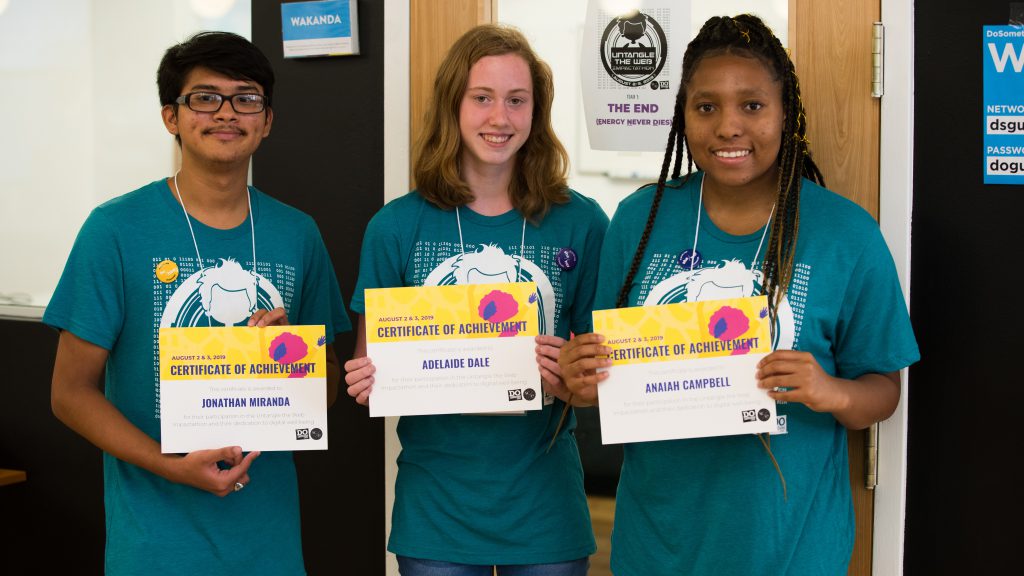
The BullyBeeGone team. © DoSomething.org
What comes next?
Based on a set of criteria that included functionality, user experience, and potential for impact, our panel of judges selected BullyBeeGone as the official winner of the hackathon. Over the next few months, DoSomething will work with BullyBeeGone’s young designers to develop a minimum viable product (MVP) that will bring this great idea one step closer to the market. We’re excited by BullyBeeGone’s potential and thrilled that young people themselves are involved at every step of the design process.
Young people have really good ideas—and they’re willing to share them. It’s up to us to listen and to help them bring those ideas to fruition. In partnership with organizations like DoSomething, we’re striving to elevate youth voice and unlock young people’s potential as true agents of change.
